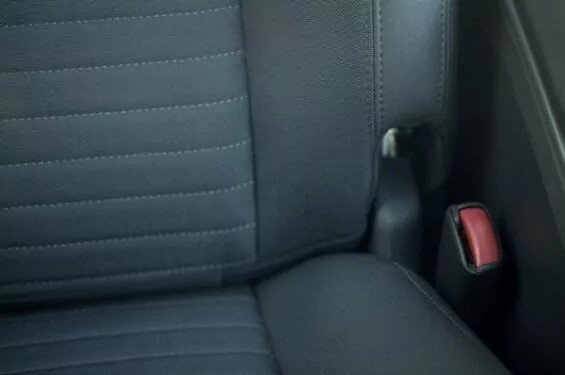Torn car upholstery can quickly diminish the appeal of your vehicle’s interior. Even a small rip or burn can detract from the overall look, especially if the rest of your interior is well-maintained. Before resorting to seat covers or expensive reupholstering services, explore these straightforward and budget-friendly methods for restoring your car’s fabric upholstery.
 Close-up of a person's hands repairing a tear in car upholstery fabric with needle and thread
Close-up of a person's hands repairing a tear in car upholstery fabric with needle and thread
1. Assess the Damage to Your Car Upholstery
The initial step in any car upholstery repair is to thoroughly assess the extent of the damage. For leather upholstery, significant damage like large holes or extensive tears might be beyond DIY repair. Furthermore, if the damage affects critical safety components such as seat belts, it’s crucial to consult a professional for repairs to ensure vehicle safety. Attempting to fix safety-related damage yourself could compromise the integrity of these systems.
While you may be able to mend a tear or hole, it’s important to have realistic expectations. Repairs, especially DIY ones, might not restore the upholstery to a factory-new condition. If the damage is in a prominent area of your car’s interior, or if you plan to keep the vehicle for a long time, professional upholstery repair could be a worthwhile investment for a seamless finish and long-lasting results.
2. Sewing Tears in Car Cloth Seats
For fabric car seats, minor tears can often be addressed with simple sewing techniques. If you’re dealing with a straightforward tear, you’ll need a curved upholstery needle and heavy-duty thread specifically designed for upholstery. Selecting a thread color that closely matches your car seats is essential for a less visible repair. If you’re new to sewing repairs, practicing your stitching on a spare piece of fabric beforehand can help you achieve a neater and more effective repair on your car seat.
Once you have carefully stitched the tear closed, apply a fabric sealant along both sides of the repaired area. This sealant will prevent the edges of the repair from fraying over time and reinforce your stitches, contributing to a more durable and longer-lasting fix for your car upholstery fabric.
3. Patching Small Holes in Car Upholstery Fabric
Repairing small holes in cloth car seats is generally a manageable DIY task, particularly if the holes are less than two inches in diameter. Common culprits for such holes include cigarette burns or damage from pets. These types of minor damage can often be effectively repaired using a heat-activated fabric interfacing. To begin, source a piece of fabric that closely matches the color and texture of your existing car upholstery to ensure a visually cohesive patch. You will also need to purchase fabric adhesive from a craft or fabric store.
Start by accurately measuring the size of the hole in your car seat. Cut a fabric patch that is slightly larger than the hole, providing a small overlap on all sides. Ensure the patch is neatly cut with straight edges, ideally forming a square or rectangle for a clean repair.
Next, cut a piece of fabric adhesive that is slightly larger than the hole you are patching. Carefully tuck the fabric adhesive into the damaged area beneath the hole, and then position your fabric patch directly on top, ensuring it covers the hole and overlaps with the surrounding upholstery. Following the manufacturer’s instructions for the fabric adhesive, use a household iron to apply heat to the fabric patch. The heat will activate the adhesive, bonding the patch to the underside of the original car upholstery fabric and effectively sealing the hole.
4. Buffing Out Scratches in Leather Car Seats
Leather car upholstery presents unique challenges compared to fabric when it comes to repairs. Unfortunately, leather is not as easily repaired with DIY methods as cloth. However, if you are only dealing with superficial scratches on your leather car seats, a high-quality leather conditioning cream might offer a solution. Apply the cream to the scratched area and use a soft cloth to buff it gently. In some cases, this buffing action and the conditioning properties of the cream can minimize the appearance of light scratches.
If leather conditioning cream alone is not sufficient to improve the appearance of scratches, you might consider using a small amount of spray lacquer specifically designed for leather repair. Apply the lacquer sparingly to the scratched area. Always adhere strictly to the manufacturer’s guidelines for application, and remember that patience is key. It is better to apply thin coats and repeat the process gradually to achieve the desired look, rather than applying too much lacquer at once, which could lead to an uneven finish or further damage.
For more specialized leather upholstery repair, or if you are unsure about using lacquer, it may be beneficial to contact your car dealership. Many dealerships offer or can recommend repair kits that are specifically formulated for your car’s interior leather, ensuring a more compatible and potentially more effective repair solution.
Regardless of whether your leather seats have scratches or not, regular cleaning and conditioning are essential for maintaining their appearance and preventing damage. For guidance on routine maintenance, explore resources on how to clean leather seats yourself using readily available household items. Proper care can significantly extend the life and beauty of your car’s leather upholstery.
For informed decision-making regarding car maintenance, potential trade-ins, or insurance coverage, understanding your vehicle’s depreciation is helpful. Utilize a car depreciation calculator to assess your car’s current value and plan accordingly.
By following these steps, you can effectively tackle minor repairs and maintain the condition of your car’s upholstery fabric, preserving the interior aesthetics and potentially saving money on professional repair services.

